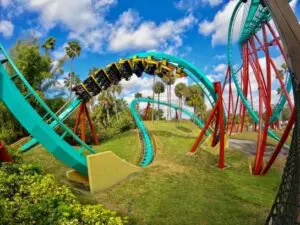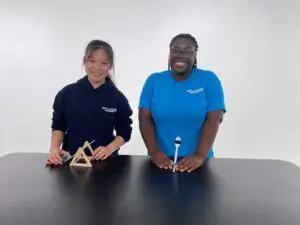- Bell, small
- Paper
- Pencils
- Variety of building materials that you have on hand, such as:
- Action figures
- Balloons
- Balls (ping-pong, tennis, rubber, etc.)
- Blocks
- Books
- Cardboard (boxes, sheets, and tubes)
- Coins
- Cups (nonbreakable)
- Dominoes
- Fan
- Funnels
- Instruments (xylophone, drum, tambourine, wind chimes, etc.)
- Marbles
- Plastic containers
- Popsicle sticks
- Rubber bands
- String or yarn
- Tape
- Toy cars
Have you ever seen a fun yet overly complex machine designed to accomplish a very simple task? If so, it may have been an “action contraption” inspired by Rube Goldberg—an engineer, inventor, and cartoonist. In this challenge, you’ll use everyday materials to build a machine that uses a chain reaction to perform a simple task.
Here are the engineering constraints for this challenge:
- The machine must produce a chain reaction consisting of four actions, each one leading to the next.
- The chain reaction must span a total distance of at least six feet.
To be successful, your design must meet the following criteria:
- The machine must successfully transfer energy to accomplish a simple task, such as ringing a bell.
Brainstorm
Rube Goldberg was an engineer, inventor, and cartoonist who lived from 1883 to 1970. He began his career as an engineer, but he quickly discovered a talent for drawing cartoons and creating comic strips. One of his characters, Professor Lucifer Gorgonzola Butts, was an inventor who created crazy, overly complicated ways to accomplish very simple tasks using chain reactions. These cartoons have inspired people to create their own real-life Rube Goldberg machines.
Your challenge is to design a Rube Goldberg machine that is made up of at least four actions and rings a bell at the end.
- Get inspired. If you’ve never seen a Rube Goldberg machine before, do an Internet search to find some simple, homemade examples. Then check out OK Go’s This Too Shall Pass music video for inspiration. Keep in mind that your machine will be much simpler than theirs!
- Consider how chain reactions work. They start with an initial action that puts energy into the “chain.” For example, you tip a domino, which falls and tips the next domino, which tips the next, and so on. Energy is transferred from one domino to another until the last domino falls off the table and launches a ball. The energy is then transferred to the ball, and the chain reaction continues.
- Watch the Challenge Video to review the parameters of the activity.
- As you start brainstorming designs, think about how you will use a chain reaction in your machine. Decide on an initial action—the energy that you will add to your machine by performing a task (like tipping a domino, pushing a toy car, or rolling a ball). Consider how the energy will be transferred from one object to the next, in a chain reaction, until it has moved through the whole machine and rings a bell at the end.
- Take a look at your materials and think about which might be fun or interesting to use in your machine. Consider including things that are visually appealing, make music or sound, or have parts that move.
- Sketch some designs or jot ideas.
Build, Test, Redesign
- Build your machine! As you build and test, consider:
- How is your machine working? What can you do to improve it?
- What are the failure points? Is there anything you can do to make it work more consistently?
- Have you included parts that move or things that are interesting to see and hear? If not, what can you add to make your machine more exciting?
- If you have a mobile device, make a video of your contraption in action—the outtakes as well as the successes!
- Consider whether you’ve met the success criteria. If not, make changes to your design and try again.
Reflect
- What did you like and dislike about the challenge?
- Which parts of your machine worked well every time? Which parts were less reliable? Why?
- What changes did you make to ensure that your action contraption worked as planned?
Did your design meet the success criteria? Nice job! Share your results with a family member, teacher, or DiscoverE! You can also share photos and videos on social media and tag @DiscoverEorg.





Thank you! Your submission is processing.